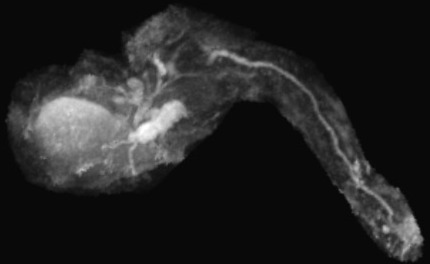Tuesday Poster Session
Category: Biliary/Pancreas
P3619 - Recurrent Gastroduodenal Artery Pseudoaneurysm With Mass Effect
Tuesday, October 29, 2024
10:30 AM - 4:00 PM ET
Location: Exhibit Hall E

Has Audio

Madeline Washburn, DO
Baylor Scott & White Medical Center
Temple, TX
Presenting Author(s)
Madeline Washburn, DO, Maryana Stryelkina, DO, Lancaster Weld, DO, James Sing, DO
Baylor Scott & White Medical Center, Temple, TX
Introduction: The incidence of visceral artery aneurysms (VAAs) has been reported to be less than 0.2%, with pseudoaneurysms involving the gastroduodenal artery (GDA) accounting for 2% of all VAAs. They commonly present with symptoms of aneurysm rupture, rarely manifesting with symptoms attributable to mass effect. To date, there have been no documented cases in the medical literature detailing biliary obstruction as a complication arising from endovascular coil embolization. Here, we describe a rare case of biliary obstruction due to extrinsic compression of the bile duct by an embolized recurrent GDA pseudoaneurysm diagnosed and successfully managed via cholangiopancreatography.
Case Description/Methods: Our patient is a 73-year-old male originally admitted for intractable nausea and vomiting. With a lipase of 4,168U/L and pain with radiation to his back, he was treated for acute pancreatitis. During his admission, he underwent a magnetic resonance cholangiopancreatography (MRCP) which showed a 4.9cm pseudoaneurysm of a duodenal vessel in an area of prior embolization near the pancreatic head. The proximal common bile duct (CBD) was dilated to 1.1cm.
The interventional radiology team performed an embolization of the GDA with coil and glue of the pseudoaneurysm. Of note, it was first coiled in 2020 when found incidentally after a motor vehicle accident.
An increasing trend in liver enzymes (alkaline phosphatase peaking at 1,048[IU]/L) led to an ultrasound notable for gallbladder sludge and intrahepatic ductal dilation. A repeat MRCP noted a stable, lysed GDA pseudoaneurysm with associated mass effect resulting in CBD narrowing and proximal dilation. An endoscopic retrograde cholangiopancreatography showed the aneurysm coiling lying adjacent to the biliary system likely causing the biliary dilation and obstructive jaundice. A 7-cm straight plastic stent was placed within the bile duct stricture. Over the next three weeks, the patient's liver enzymes returned to normal limits.
Discussion: GDA pseudoaneurysms are usually described in context of resultant hemorrhage. Manifestations related to mass effect, such as biliary obstruction, are rare presentations of this condition. Diagnosing a recurrent embolized GDA pseudoaneurysm as the underlying etiology of extrahepatic biliary obstruction represents a diagnostic challenge due to its unique presentation. This case highlights the importance of cholangiopancreatography in the setting of GDA post-endovascular coil embolization in those with biliary enzyme elevation.

Disclosures:
Madeline Washburn, DO, Maryana Stryelkina, DO, Lancaster Weld, DO, James Sing, DO. P3619 - Recurrent Gastroduodenal Artery Pseudoaneurysm With Mass Effect, ACG 2024 Annual Scientific Meeting Abstracts. Philadelphia, PA: American College of Gastroenterology.
Baylor Scott & White Medical Center, Temple, TX
Introduction: The incidence of visceral artery aneurysms (VAAs) has been reported to be less than 0.2%, with pseudoaneurysms involving the gastroduodenal artery (GDA) accounting for 2% of all VAAs. They commonly present with symptoms of aneurysm rupture, rarely manifesting with symptoms attributable to mass effect. To date, there have been no documented cases in the medical literature detailing biliary obstruction as a complication arising from endovascular coil embolization. Here, we describe a rare case of biliary obstruction due to extrinsic compression of the bile duct by an embolized recurrent GDA pseudoaneurysm diagnosed and successfully managed via cholangiopancreatography.
Case Description/Methods: Our patient is a 73-year-old male originally admitted for intractable nausea and vomiting. With a lipase of 4,168U/L and pain with radiation to his back, he was treated for acute pancreatitis. During his admission, he underwent a magnetic resonance cholangiopancreatography (MRCP) which showed a 4.9cm pseudoaneurysm of a duodenal vessel in an area of prior embolization near the pancreatic head. The proximal common bile duct (CBD) was dilated to 1.1cm.
The interventional radiology team performed an embolization of the GDA with coil and glue of the pseudoaneurysm. Of note, it was first coiled in 2020 when found incidentally after a motor vehicle accident.
An increasing trend in liver enzymes (alkaline phosphatase peaking at 1,048[IU]/L) led to an ultrasound notable for gallbladder sludge and intrahepatic ductal dilation. A repeat MRCP noted a stable, lysed GDA pseudoaneurysm with associated mass effect resulting in CBD narrowing and proximal dilation. An endoscopic retrograde cholangiopancreatography showed the aneurysm coiling lying adjacent to the biliary system likely causing the biliary dilation and obstructive jaundice. A 7-cm straight plastic stent was placed within the bile duct stricture. Over the next three weeks, the patient's liver enzymes returned to normal limits.
Discussion: GDA pseudoaneurysms are usually described in context of resultant hemorrhage. Manifestations related to mass effect, such as biliary obstruction, are rare presentations of this condition. Diagnosing a recurrent embolized GDA pseudoaneurysm as the underlying etiology of extrahepatic biliary obstruction represents a diagnostic challenge due to its unique presentation. This case highlights the importance of cholangiopancreatography in the setting of GDA post-endovascular coil embolization in those with biliary enzyme elevation.

Figure: MRCP showing GDA pseudoaneurysm with proximal CBD dilation secondary to mass effect.
Disclosures:
Madeline Washburn indicated no relevant financial relationships.
Maryana Stryelkina indicated no relevant financial relationships.
Lancaster Weld indicated no relevant financial relationships.
James Sing indicated no relevant financial relationships.
Madeline Washburn, DO, Maryana Stryelkina, DO, Lancaster Weld, DO, James Sing, DO. P3619 - Recurrent Gastroduodenal Artery Pseudoaneurysm With Mass Effect, ACG 2024 Annual Scientific Meeting Abstracts. Philadelphia, PA: American College of Gastroenterology.
